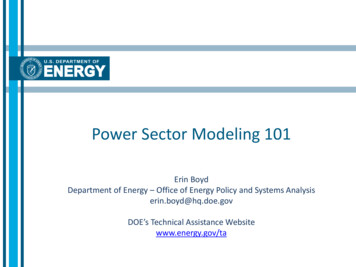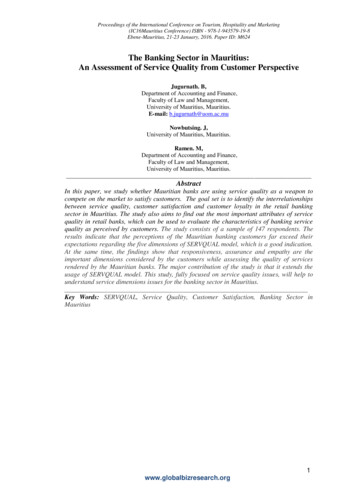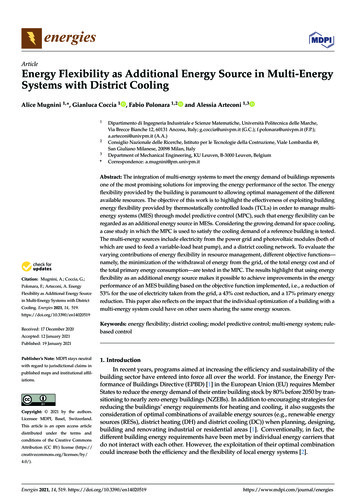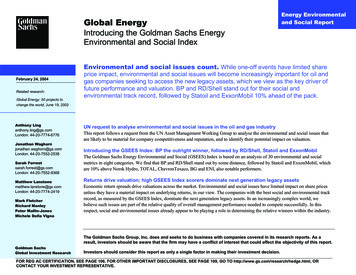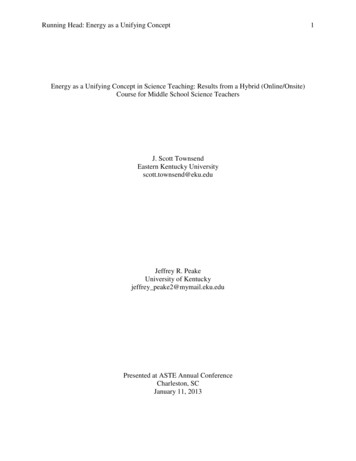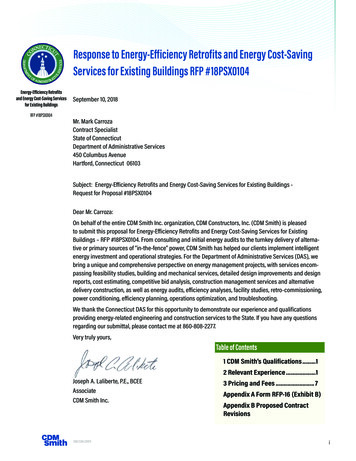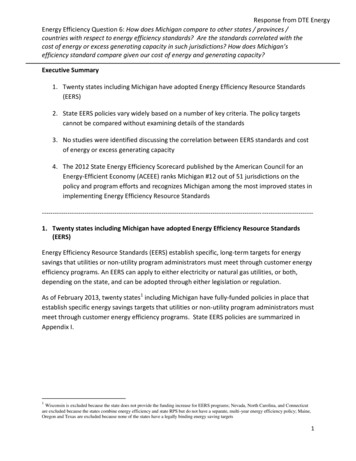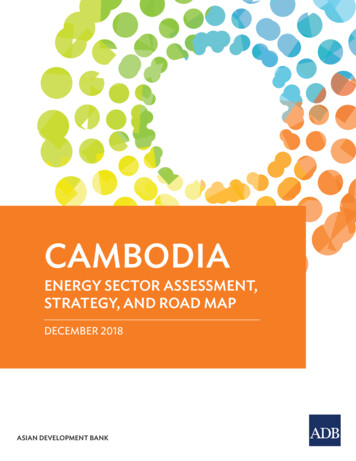
Transcription
CAMBODIAEnERgy SECtOR ASSESSMEnt,StRAtEgy, AnD ROAD MApdecember 2018ASIAN DEVELOPMENT BANK
CAMBODIAEnergy Sector Assessment,Strategy, and Road Mapdecember 2018ASIAN DEVELOPMENT BANK
Creative Commons Attribution 3.0 IGO license (CC BY 3.0 IGO) 2018 Asian Development Bank6 ADB Avenue, Mandaluyong City, 1550 Metro Manila, PhilippinesTel 63 2 632 4444; Fax 63 2 636 2444www.adb.orgSome rights reserved. Published in 2018.ISBN 978-92-9261-450-8 (print), 978-92-9261-451-5 (electronic)Publication Stock No. TCS189801DOI: http://dx.doi.org/10.22617/TCS189801The views expressed in this publication are those of the authors and do not necessarily reflect the views and policiesof the Asian Development Bank (ADB) or its Board of Governors or the governments they represent.ADB does not guarantee the accuracy of the data included in this publication and accepts no responsibility for anyconsequence of their use. The mention of specific companies or products of manufacturers does not imply that theyare endorsed or recommended by ADB in preference to others of a similar nature that are not mentioned.By making any designation of or reference to a particular territory or geographic area, or by using the term “country”in this document, ADB does not intend to make any judgments as to the legal or other status of any territory or area.This work is available under the Creative Commons Attribution 3.0 IGO license (CC BY 3.0 o/. By using the content of this publication, you agree to be boundby the terms of this license. For attribution, translations, adaptations, and permissions, please read the provisionsand terms of use at https://www.adb.org/terms-use#openaccess.This CC license does not apply to non-ADB copyright materials in this publication. If the material is attributedto another source, please contact the copyright owner or publisher of that source for permission to reproduce it.ADB cannot be held liable for any claims that arise as a result of your use of the material.Please contact pubsmarketing@adb.org if you have questions or comments with respect to content, or if you wishto obtain copyright permission for your intended use that does not fall within these terms, or for permission to usethe ADB logo.Notes:ADB recognizes "China" as the People's Republic of China and "Vietnam" as Viet Nam.In this publication, “ ” refers to United States dollars.Corrigenda to ADB publications may be found at http://www.adb.org/publications/corrigenda.Printed on recycled paper
ContentsTables and Figures ivAcknowledgments vAbbreviations viCurrency Equivalents iSector Assessment A. Introduction B. General Country Context C. Overview of the Energy Sector D. Electricity Subsector Assessment E. Key Subsector Constraints and Development Needs iii Sector Strategy A. Government Sector Strategy, Policy, and Plans B. ADB Sector Support Program and Experience C. ADB Self-Evaluation D. Other Development Partner Support E. ADB Sector Strategy F. Lending and Nonlending Program and Resource Needs viii1112133034343639414545iii Energy Sector: Road Map and Results Framework, 2019–2023 49Appendix: Energy Sector Problem Tree 51
Tables and FiguresTables1.ADB Approved Loans and Grants for the Energy Sector, 1994–2016 362.Ongoing Development Partner Projects and Programs 41Figures1. Separation of Responsibilities between the Ministry of Mines and Energy and Electricity Authority of Cambodia92.Organizational Chart of Electricite du Cambodge 113.Peak Demand on the National Grid 144. Energy Generation by Fuel Type, 2014–2030 155. Cambodia’s Installed Capacity and Demand Forecast, 2014–2030 176. Distribution License Zone Granted and Medium-Voltage Backbone Constructed by 2016197.21Goal of National Grid Development by 2020 8. Electricite du Cambodge System Losses, 2003–2016 229. Electricite du Cambodge Distribution Losses, 2009-2016 2210. Growth of Electrification in Cambodia, 2003–2017 26
AcknowledgmentsThis work was conducted under the technical supervision of Pradeep Tharakan (principalclimate change specialist, Energy Division, Southeast Asia Department), with additionalinputs from Jan Hansen (senior country economist, Cambodia Resident Mission) of theAsian Development Bank (ADB). Additional guidance and support was provided by AndrewJeffries (director, Energy Division, Southeast Asia Department). The report was written by JulieCasabianca (consultant, ADB) with contributions from Anthony Jude (consultant, ADB), WilliamDerbyshire (consultant, ADB), and Stuart Thorncraft (consultant, ADB). The team wishes tothank Yongping Zhai (chief, Energy Sector Group, Sustainable Development and Climate ChangeDepartment) as the report’s peer reviewer.The team wishes to thank the Ministry of Mines and Energy, Electricite du Cambodge, ElectricityAuthority of Cambodia, and development partners for their inputs and discussions during thepreparation of the report. The team also thanks colleagues from the Cambodia Resident Missionand the Department of Communications for their support.DirectorAndrew Jeffries, Energy Division, Southeast Asia Department (SERD)Team leaderPradeep Tharakan, principal climate change specialist, SERDTeam membersJeffrey Almera, senior operations assistant, SERDChristine Samaniego, associate project analyst, SERDPeer reviewerYongping Zhai, chief, Energy Sector Group, Sustainable Development andClimate Change Department
AbbreviationsADBAsian Development BankAFDAgence Française de DéveloppementASRassessment, strategy, and road mapCCAPClimate Change Action PlanCPScountry partnership strategyEACElectricity Authority of CambodiaEDCElectricite du CambodgeEUEuropean UnionGMSGreater Mekong SubregionIDPIndustrial Development PolicyIPPindependent power producerJICAJapan International Cooperation AgencyLao PDRLao People’s Democratic RepublicMEFMinistry of Economy and FinanceMMEMinistry of Mines and EnergyNCSDNational Council for Sustainable DevelopmentNSDPNational Strategic Development PlanOCAOverlapping Claims AreaPDPPower Development PlanPPApower purchase agreementPRCPeople’s Republic of ChinaPSODPrivate Sector Operations DepartmentPVphotovoltaicREErural electricity enterprise
AbbreviationsREFRural Electrification FundRPTCCRegional Power Trade Coordination CommitteeSHSsolar home systemSREPScaling Up Renewable Energy Program in Low Income CountriesTAtechnical assistanceWEIGHTS AND tt-peakvii
Currency Equivalents(as of 15 November 2018)Currency unit riel/s (KR)KR1.00 0.00024763 1.00 KR4,038.34
I. Sector AssessmentA.Introduction1.This sector assessment, strategy, and road map (ASR) documents the current analysisof the Asian Development Bank (ADB) of the strategic investment priorities of the Governmentof Cambodia and ADB in Cambodia’s energy sector. It highlights sector performance, majordevelopment constraints, government plans and strategy, past ADB support and experience,other development partner support, and ADB’s future support strategy. The ASR is alignedwith ADB’s new Strategy 20301 and will inform ADB’s country partnership strategy (CPS) forCambodia, 2019–2023, which is currently under development. The ASR has been prepared asa living document and will help to provide sector background information for investment andtechnical assistance (TA) operations.B.General Country Context2.Cambodia has a land area of 181,035 square kilometers and a population of about15.25 million in 2016. The population grew rapidly in the 1980s and 1990s, and continues toannually increase by about 1.3%, or almost 200,000 people. The age dependency ratio inCambodia of 55% shows that the working-age population (aged 15–64) faces a greater burdento support the youth and elderly. The country is urbanizing rapidly, but from a low level. In 2017,77.0% of the population still lived in rural areas, down from 80.8% in 2005.23.Cambodia’s economy grew quickly with an average growth rate of 7.0% from 2006to 2016, with poverty falling substantially from 47.8% in 2007 to 14.0% in 2014.3 The countrygraduated from low-income status to lower middle-income status in 2015. Nonetheless, thegross domestic product per capita, estimated at 1,447 in 2017, remains among the lowest inAsia. In 2017, agriculture contributed 25.0% of the gross domestic product, industry contributed32.7%, and services contributed 42.3%. The main subsectors in industry are garment production,construction, and food and beverage processing.41234ADB. 2018. Strategy 2030: Achieving a Prosperous, Inclusive, Resilient, and Sustainable Asia and the Pacific. Manila.ADB. 2018. Basic Statistics 2018. Manila; and ADB. 2018. Key Indicators for Asia and the Pacific 2018. Manila.ADB. 2018. Report and Recommendation of the President to the Board of Directors: Proposed Loan and Grant to the Kingdomof Cambodia for the Second Urban Environmental Management in the Tonle Sap Basin Project. Country Economic Indicators(accessible from the list of linked documents in Appendix 2). Manila; and ADB. 2018. Basic Statistics 2018. Manila.Government of Cambodia. 2015. Cambodia Industrial Development Policy, 2015–2025: Market Orientation and EnablingEnvironment for Industrial Development. Phnom Penh.
2Cambodia Energy Sector Assessment, Strategy, and Road Map4.Nearly 5 million Cambodians have no access to grid electricity and are reliant on carbatteries, wood, and other traditional fuels for energy.5 For cooking, about 62% of householdsuse firewood, 5% use charcoal, 31% use liquefied petroleum gas, and 2% use electricity.6 Thetraditionally high electricity tariff in the country makes access unaffordable to the poor whileconstraining economic competitiveness and discouraging investment. Recognizing thatexpanded access to modern and affordable forms of energy is essential for Cambodia’s socialand economic advancement, the Government of Cambodia’s National Strategic DevelopmentPlan (NSDP), 2014–20187 and Industrial Development Policy (IDP), 2015–2025 (footnote 4)prioritize the need to develop the energy sector in an affordable and sustainable manner, whilealso taking into account the need to minimize adverse environmental and social impacts.C.Overview of the Energy Sector1.Primary Energy Supply and Demand5.The total primary energy supply in Cambodia was about 4.8 million tons of oil equivalentin 2015.8 Fuel wood and other biomass accounted for an estimated 44.4% of the total, oil andpetroleum products for 38.5%, coal for 10.7%, hydropower for 3.6%, and electricity imports for2.8%. The share of coal and hydropower in Cambodia’s energy supply increased significantly from2010 to 2015 with the commissioning of new coal and hydropower plants; during this period, theshare of coal increased from 0.7% to 10.7%, while the share of hydropower increased from 0.1%to 3.6% (footnote 8).6.Total final energy consumption in Cambodia grew by an annual average of 6.9% during2010–2015. Final energy consumption in 2015 was 3.4 million tons of oil equivalent, comprising50.5% petroleum products, 36.0% biomass, 13.1% electricity, and 0.4% coal. The transport sectoris responsible for nearly half (46%) of final energy consumption. In terms of fuel uses, more than40% of biomass is used in the residential sector for cooking and heating, another 40% is used toproduce charcoal (which is also consumed by households), approximately 15% is used in industry,and a small portion contributes to electricity generation. Final consumption of petroleum productsis divided by sector as follows: 87% for transport; 6% for industry; 4% for agriculture, service, andresidential; and 3% for power generation. Most of the coal consumption is for power generation(97%) while 3% is used in industry. The rapid increase in coal usage is due to the commissioningof two coal-fired power plants in Preah Sihanouk Province in 2014–2017, part of the government’splan to reduce oil-based power generation. Primary energy use increased steadily from 2009 to2016 due to economic and population growth, but considering the country’s stage of economicdevelopment, it remains low. At about 480 kilograms of oil equivalent per capita per year in 2016,energy use is about 65% of the Asian average of 740 kilograms, according to the InternationalEnergy Agency.956789In 2017, 69% of households had access to grid-connected electricity. Electricity Authority of Cambodia (EAC). 2018.Salient Features of Power Development in Kingdom of Cambodia. Phnom Penh.World Bank. 2018. Cambodia—Beyond Connections: Energy Access Diagnostic Report Based on the Multi-Tier Framework.Washington, DC.Government of Cambodia. 2014. National Strategic Development Plan, 2014–2018. Phnom Penh.Government of Cambodia, Ministry of Mines and Energy, and Economic Research Institute for Association of SoutheastAsian Nations and East Asia. 2016. Cambodia National Energy Statistics 2016. Jakarta.International Energy Agency. Statistics (accessed 25 September 2018). The Asian average excludes the People’s Republicof China.
Sector Assessment7.With continuing population growth, economic growth, and urbanization, ADB predictsthat the country’s energy needs will double by 2030. While hydropower and thermal generation(coal or natural gas) are replacing oil in electricity generation (each is projected to accountfor roughly half of electricity production by 2030 in the Government of Cambodia’s PowerDevelopment Plan [PDP], 2015–203010), the use of petroleum products is expected to increasewith rising demand in the transport, industry, and residential sectors. Demand for oil will be drivenprimarily by demand for diesel and gasoline as the country becomes more motorized and as thegovernment promotes industrial zones for manufacturing and agro-processing. In the residentialsector, use of liquid petroleum gas is expected to increase as kerosene is phased out.2.Fossil Fuel Resources8.Cambodia imports all fossil fuels t
2 cambodia energy Sector Assessment, Strategy, and road map 4. Nearly 5 million Cambodians have no access to grid electricity and are reliant on car batteries, wood, and other traditional fuels for energy.5 For cooking, about 62% of households use firewood, 5% use charcoal, 31% use liquefied petroleum gas, and 2% use electricity.6 The

